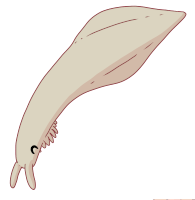Pikaia gracilens
Walcott, 1911
Middle Cambrian
Burgess Shale, Stephens Formation
Field, British Columbia, Canada

Pikaia looks like a small, vertically flattened eel, with 2 tentacles in front of a slightly formed head. Some myomeres are lightly visible on this specimen. They are blocks of skeletal muscle, segmented by vertebra, that you can easily see for instance on the flesh of fishes. In addition to the head and myomeres, a dorsal neural system and a notochord makes Pikaia a possible precursor of the vertebrates. This discovery makes it one of the most iconic animal from the Burgess shales and possibly one of our remote direct ancestor.
This specimen comes from a large collection done by a geologist named Lowell Laudon, who used to take annual summer field trips to the site in the 1930’s, and specimens of which were scattered at his death in the 80s. Probably collected from the Raymond Quarry, as the matrix color is fairly distinctive for that site.
Early chordate is 33mm on an 84mm slab. It shows the classic silver reflectivity of most Burgess Shale specimens and has no repair or reconstruction.
The myomeres are easily visible, but they also don’t show much detail so this specimen probably underwent some decay before preservation.
Acquisition: 2019-06-18
Burgess Shale
Discovered in 1911 by Charles Walcott, the fossils site of Burgess contains the remains of a marine biotope, composed of several species, of various forms and sizes. It is famous for the exceptional preservation of the soft parts of its fossils, which allowed for a detailed study of anatomy of worms, arthropods and other misunderstood forms at the time.
Early 1970, 3 british paleontologists, Harry Whittington, Derek Briggs and Simon Conway Morris began a thorough reassessment of the Burgess Shale. They realised that the fauna was much more complex and unusual than formerly described. Thus was discovered the Cambrian explosion phenomenon, popularized by Stephen Jay Gould's "Wonderful Life" book.
Before this bloom of diversity of body plans, most of living organisms were composed of individual cells living in colony. Cambrian sees the sudden appearance of all modern animal phyla, including our own one, almost simultaneously in a rather short span of geological period.
Today the Burgess shale is a UNESCO World Heritage site and no collection is allowed on-site. However, prior to the Royal Ontario Museum rediscovering Walcott's collection in 1966, there was a period of over 50 years when Canadian researchers didn't have any interest in the site. During that time, it was an interesting curiosity that was open to collecting and a wide variety of teachers, collectors, hobbyists and the like visited the site and collected specimens.
The fossils presented on this website are coming from these existing private collections of Burgess Shale material, especially from a collection of Lowell Laudon, as well as from specimens sent by Walcott himself to other geologists.